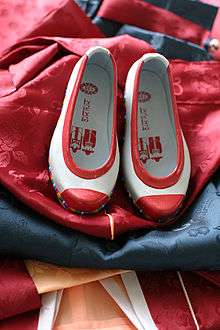Gomusin
- This is an article about Korean rubber shoes. For a cultural term, see gomsin.
- Not to be confused with term for athletic shoes in Philippine English (i.e., rubber shoes).
| Gomusin | |
 | |
| Korean name | |
|---|---|
| Hangul | 고무신 |
| Hanja | none |
| Revised Romanization | gomusin |
| McCune–Reischauer | komusin |
Gomusin (Korean pronunciation: [komuɕʰin]) are shoes made of rubber in a form of Korean traditional shoes. The shoes are wide, with low heels. Gomusin for men were modeled after "gatsin" (갖신), and ones for women were danghye (당혜). Gomusin first appeared in the early 20th century. They were much easier to keep clean than danghye and jipsin (straw shoes) and they could be worn when it rains. Therefore, gomusin gained a popularity and replaced traditional shoes.[1][2]
History
It is purported that the first man to wear gomusin was Sunjong of Korea, the last Choseon emperor. From 1938 to 1945, the Japanese colonial régime restricted the wearing of national dress including gomusin. From 1945 to the end of the Korean War the now legalized shoes became very popular. After 1960, while the manufacture of gomusin became more sophisticated and more appealing styles were able to proliferate, gomusin became less common in everyday dress.[3]
See also
References
- ↑ "There's no business like shoe business". Retrieved 2015-12-15.
- ↑ "'고무신' – 네이트 백과사전". June 10, 2011. Archived from the original on June 10, 2011. Retrieved 2015-12-15.
- ↑ 한국민족문화대백과. "고무신의 역사". 네이버 지식백과.